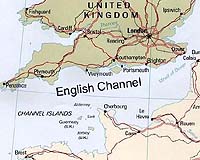| . |  |
. |
Durban, South Africa (AFP) Oct 29, 2010 Underwater canyons, deep-sea coral reefs and sponge banks are part of a unique ecosystem that South Africa wants to save within its first deep-sea marine protected area. After 10 years of consultations, South Africa has mapped the boundaries for the proposed reserve stretching 100 kilometres (60 miles) from the eastern KwaZulu-Natal coast. The mapping required synthesising the many divergent interests in the Indian Ocean waters, with 40 industries from fishing to gas lines to jet skis operating in an area home to about 200 animal species and their ecosystems. "All of this data was then entered into conservation planning software in order to identify areas of high biodiversity while avoiding areas of high (economic) pressure," said Tamsyn Livingstone, the researcher who heads the project. The conservation area is being born in a spirit of compromise, which will allow people and companies to continue using the protected waters in zones designated as lower-risk threats to biodiversity. The scheme still needs to be passed into law, but would join South Africa's existing network of marine preserves strung along its 3,000-kilometre (1,800-mile) coast stretching from the warm Indian Ocean to the cold southern Atlantic. South Africa has embraced this "participatory" method to protecting species living in its water, an approach pioneered in California and Australia. Global goals for protecting biodiversity have been debated for two weeks at a UN summit in Nagoya, Japan, in an effort to set goals on saving habitats which would help to end the mass extinction of species. Environmental groups want 20 percent of coastal and marine areas protected, they say China and India are lobbying for six percent or lower. Talks are supposed to wrap up on Friday. Part of the challenge is in protecting species that are more often than not still unknown. Only one quarter of the estimated million species in the oceans have been discovered. A global census of the oceans unveiled in early October uncovered prehistoric fish thought dead millions of years ago, capturing researchers' imaginations about what else lurks in the deepest parts of the sea. "Offshore biodiversity is not well known," said Kerry Sink of the South African National Biodiversity Institute. Exploring the seas remains an expensive project, prompting South African researchers to reach agreements to share information with fisheries, coastal diamond mines and the oil industry. "South Africa's plan is unique in covering all industry sectors to ensure that biodiversity planning minimizes the impact on industry," she said. "Healthy offshore ecosystems underpin healthy fisheries and keep options open for future generations." With growing worries about climate change, scientists say the deep seas could become an important source of protein for the planet, because water temperature changes less at great depths. That assumes that the growth of industry can be managed alongside the marine life, especially as oil companies find ways to drill in ever-deeper waters. The explosion of a BP oil rig in April off the Louisiana coast, rupturing a 1,500-metre deep well, highlighted the risks. It took five months to shut off the leak which caused the biggest the oil spill in US history, with 205 million gallons of oil flowing into the Gulf.
Share This Article With Planet Earth
Related Links Water News - Science, Technology and Politics
 Britain announces marine 'planning' zones
Britain announces marine 'planning' zonesLondon (UPI) Oct 28, 2010 An area of the North Sea has been chosen as the first region off England's coast to be subject to a marine planning system, authorities say. The first area extends 125 miles off the country's east coast, and the marine plan aims to subject ocean projects to the same level of planning approval required for efforts on land, the BBC reported Thursday. The zone will be the first of 1 ... read more |
|
| The content herein, unless otherwise known to be public domain, are Copyright 1995-2010 - SpaceDaily. AFP and UPI Wire Stories are copyright Agence France-Presse and United Press International. ESA Portal Reports are copyright European Space Agency. All NASA sourced material is public domain. Additional copyrights may apply in whole or part to other bona fide parties. Advertising does not imply endorsement,agreement or approval of any opinions, statements or information provided by SpaceDaily on any Web page published or hosted by SpaceDaily. Privacy Statement |